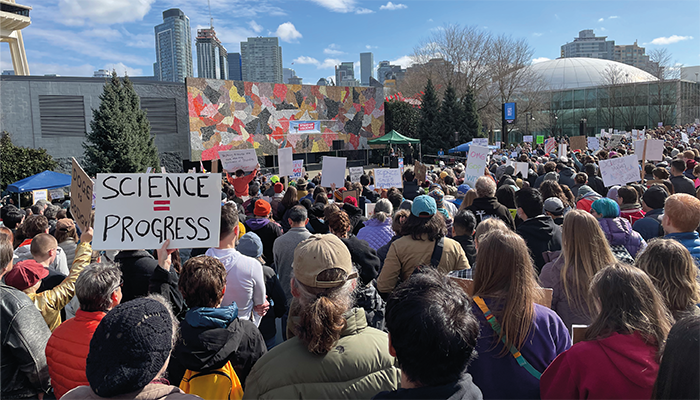
Credit: Stand Up For Science in Seattle 2025 by LivingBetterThroughChemistry, CC BY-SA 4.0, via Wikimedia Commons
A solid-phase extraction method coupled with ultra-performance liquid chromatography-tandem mass spectrometry (SPE-UHPLC-MS/MS) enables trace-level detection and quantification of 19 bisphenol analogues in drinking water. Link
Researchers develop a highly-efficient catalyst for water oxidation in aqueous media, confirming its multinuclear iron complex with electron spray ionisation time-of-flight mass spectrometry (ESI-TOF-MS). Link
Ultra-performance liquid chromatography-quadrupole time-of-flight mass spectrometry (UPLC-Q-TOF/MS) applied to chemical characterization of meiju oral liquid, a Chinese medicinal formula. Link
Researchers from the Jožef Stefan Institute determine the static limit of megaelectronvolt (MeV) secondary ion mass spectrometry (SIMS), before investigating the dynamics of secondary ion mass spectra following prolonged primary ion bombardment. Link
A combination of air-flow-assisted desorption electrospray ionization (AFADESI-MSI) with matrix-assisted laser desorption ionization (MALDI-MSI) enables comprehensive spatial analysis of metabolic changes in model rats with diabetic liver injury (DLI) – with additional tests to demonstrate the therapeutic effects of ferulic acid. Link
Bird Lungs Reveal Extent of Airborne Microplastic Pollution
According to a new study, microscopic plastic pollutants are infiltrating the lungs of birds, raising concerns about potential risks to human health. Using laser direct infrared (LDIR) spectroscopy and pyrolysis gas chromatography-mass spectrometry (Py-GC-MS), researchers analyzed lung tissue from 56 birds spanning 51 species, detecting a high prevalence of microplastics and nanoplastics in the birds’ respiratory systems.
"Our research highlights an urgent need to address plastic pollution in our environments, as these contaminants can have far-reaching impacts on ecosystem health, as well as human health," explained Shane DuBay, an assistant professor of biology at UTA and study co-author, in a press release… Read more!
Looking Back, Moving Forward: With Deirdre Cabooter
Continuing our series of reflections on current and future trends in analytical science, Deirde Cabooter highlights how trends such as the rise of AI and increased accessibility to mass spectrometers are aiding the field’s growth.
“Another significant accomplishment is the development and increased accessibility of affordable, user-friendly, high-resolution mass spectrometers. These instruments have become more common in laboratories, which is fantastic because it means more people have access to high-resolution techniques and their improved sensitivities. One application I’ve found to be particularly fascinating is their use in real-time measurements, such as in operating rooms, where they’re used to make on-the-spot decisions on whether tissue is cancerous or healthy…” Read more!
Mass Action
Last Friday saw thousands of researchers, students, and allies of science take to the streets as part of the #StandUpForScience movement in opposition to recent rulings made by the US government. Their feeling of angst was one shared by Erin Baker, who spoke to us recently about her thoughts on the developments: “Ultimately, science cannot start to move forward again until order is restored, chaos is removed, and our researchers and thinkers are no longer under attack.”
Did you attend a local rally? Any thoughts on the news? We’d love to hear them.




